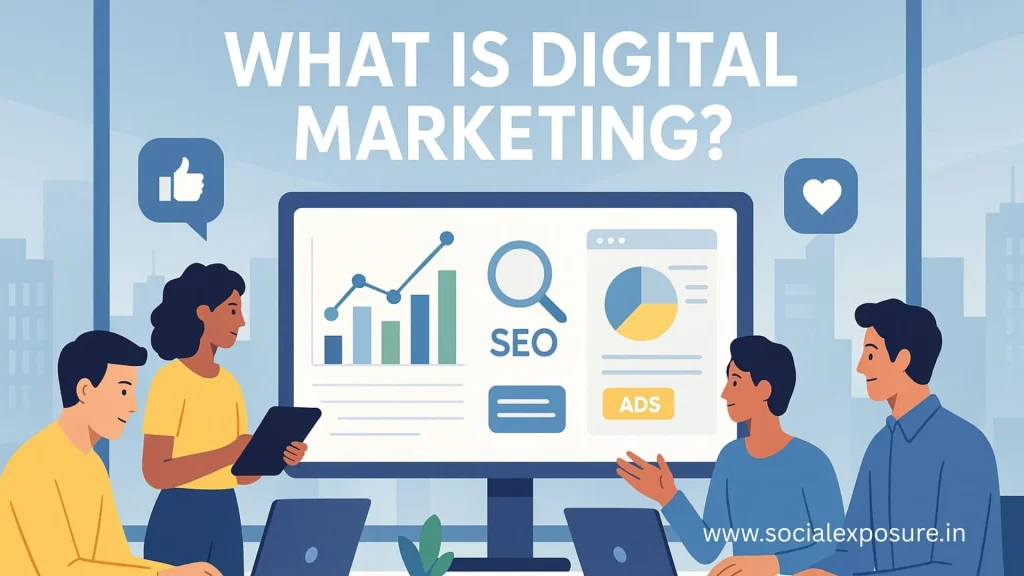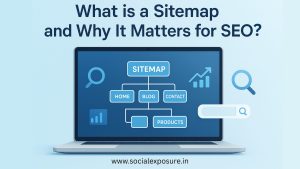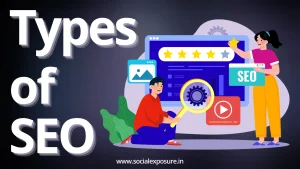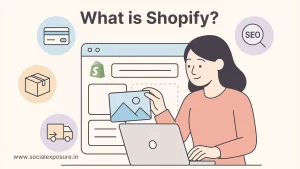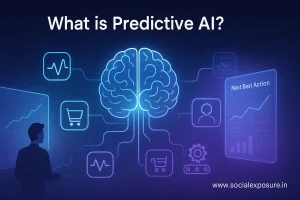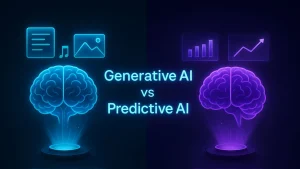If you’ve ever wondered how brands show up in your search results, appear on your social feeds, or send you that one email just when you’re thinking about a product, you’re already seeing digital marketing in action. But knowing it exists and actually understanding how it works are two different things.
For business owners, it’s often a decision between growing organically or paying for visibility. For students or early professionals, it’s a potential field of learning and work. For startup founders, it’s about building a presence with limited budgets. And for e-commerce stores or bloggers, it’s a way to turn visibility into income.
Everyone interacts with digital marketing, but not everyone gets how it truly functions and more importantly, how to use it with purpose. So let’s keep it simple.
This blog isn’t another surface-level explainer. It won’t dump long lists of jargon or confuse you with abstract strategy. Instead, it’ll walk you through what really matters what digital marketing means today, how it’s shaping the way businesses grow, and what it takes to use it effectively.
We’ll focus on clear understanding, real-world use, and the kinds of choices that help users like you move forward with confidence.
To give you an idea of why this matters, consider this: According to a recent Statista report, over 5.56 billion people worldwide now use the internet, and more than 5.24 billion actively engage on social media. These are not just numbers. They represent people, preferences, and purchase behavior all happening digitally. Understanding how to tap into that isn’t just useful. It’s essential.
This guide by Social Exposure helps you get started the right way.
What is Digital Marketing?
To understand what digital marketing is, think of it as the way businesses now reach people where they spend most of their time—on screens. Instead of billboards or cold calls, brands use websites, emails, search engines, and apps to connect, inform, and influence. At its core, digital marketing means promoting products or services through modern marketing channels that rely on the internet.
While traditional marketing worked through physical mediums like newspapers and radio, this shift began when internet usage surged globally. The first banner ad appeared on October 27 1994. By 2000, internet marketing had become a serious channel. Today, it’s no longer optional, it’s how growth happens.
Data from the International Telecommunication Union shows global internet penetration crossed 68 percent in 2024, with users spending over six hours daily online. This behavior shift has changed how decisions are made. From searching a product to reading reviews and clicking purchase, much of the customer journey now happens online. Digital marketing exists to meet those moments.
So when someone asks for the digital marketing meaning, it’s not just about ads or algorithms. It’s about using digital tools to meet people, solve needs, and build relationships wherever they are online.
Why is Digital Marketing Important Today?
When people look something up, check reviews, watch a video, or ask for recommendations, they’re using online platforms. And that’s exactly where businesses need to be. The importance of digital marketing comes from this shift in user behavior. Attention isn’t divided anymore it’s concentrated across just a few major digital platforms.
Instead of relying on one ad in one newspaper, brands now have the chance to meet users across search, social, email, and mobile often in the same day. That’s not just visibility, it’s consistency. And in an environment where people scroll fast and decide faster, that consistent presence can shape trust.
As the growing online audience continues to expand, digital becomes the only space where small businesses, startups, and global enterprises share a level playing field. It’s not just about reach. It’s about timing and relevance.
Those who keep their strategies aligned with current user behavior tend to move forward faster. That’s where Social Exposure helps brands stay ahead with thoughtful, updated approaches built around how people interact online right now.
How Does Digital Marketing Work?
Understanding how digital marketing works starts with one question: who are you trying to reach? Every digital strategy begins with customer targeting—figuring out where your audience spends time, what they care about, and how they make decisions online.
Once that’s clear, the next step is communication. Businesses create messaging and offers that align with what people actually want. This can show up in different forms depending on the platform or the stage of the customer journey. Some common formats include:
- Social media marketing: helps share ideas, updates, and interact with followers in real time.
- Email marketing: used to build long-term relationships, send reminders, or deliver offers directly.
- Content creation: through blogs, videos, or guides, businesses explain value and answer real questions.
Behind the scenes, data helps track performance. From how many people click to how long they stay, every step is measured. This allows businesses to improve what’s working and adjust what isn’t.
Agencies like Social Exposure simplify this for clients with proven workflows built around strategy, content, and measurable growth.
Types of Digital Marketing
Different businesses use different channels, depending on their audience and goals. Here’s a quick look at the most common types of digital marketing, each serving a unique purpose in reaching people online.
Social Media Marketing
SMM involves creating content and running campaigns on platforms like Instagram, Facebook, LinkedIn, and others. It helps brands connect with their audience in real time and build a voice people can relate to.
Content Marketing
Through blogs, articles, videos, and guides, businesses explain their products, share expertise, and help users make decisions. It’s not about selling, it’s about offering real value through information.
Search Engine Optimization (SEO)
This helps websites show up in search engines like Google. When someone types a query, SEO helps make sure the right pages are found. It includes using keywords, improving content structure, and making sites easier to read for both users and search engines.
Email Marketing
Businesses often use email marketing to stay connected with customers. Whether it’s a welcome email, a product update, or a reminder, it allows brands to reach people directly in their inbox.
Affiliate Marketing
This is a performance-based model where businesses pay commissions to people or websites that promote their products. It’s popular in the blogging and influencer space, especially in product-heavy markets.
Pay-Per-Click
In this method, advertisers pay only when someone clicks on their ad. Common platforms include Google Ads and sponsored listings on social media. It’s helpful for quick visibility or when launching something new.
Voice Search Marketing
With smart assistants becoming more common, people now ask questions out loud. This type of marketing focuses on optimizing content for spoken queries short, clear, and directly answering what users are saying.
Mobile Marketing
This includes any outreach designed for mobile users. It could be SMS updates, app-based promotions, or mobile-friendly websites. Since most traffic today comes from phones, this is no longer optional.
Audio Marketing
This refers to ads and branded messages delivered through podcasts, music apps, or audio streaming platforms. It allows brands to be heard without interrupting the user experience.
Influencer Marketing
By partnering with individuals who have built trust with specific audiences, brands get access to loyal followers. It works well for product promotions, niche categories, and community building.
At the end of the day, whether it’s a short message, a search result, a podcast mention, or a reel that sticks, Social Exposure makes sure your brand shows up in the right place, at the right time, and in the right way.
Digital Marketing vs Traditional Marketing
When choosing between digital and traditional methods, it often comes down to cost, reach, and tracking. The difference between digital marketing and traditional marketing is how they approach the audience. Traditional relies on offline mediums like print or TV. Digital operates where people are actively spending time on phones, browsers, and apps.
What makes digital stand out is its flexibility. It’s often more scalable, quick to launch, and data-driven. You can test what works, pause what doesn’t, and reach people when and where they’re ready. For businesses looking for measurable marketing and cost-effective advertising, digital often makes more sense especially when working with limited budgets.
Feature | Traditional Marketing | Digital Marketing |
Format | Print, radio, TV, outdoor | Search, email, social, video |
Audience Reach | Local or regional | Local to global |
Cost Flexibility | Fixed, often higher | Adjustable, fits any budget |
Tracking Results | Hard to measure | Real-time performance data |
Campaign Adjustments | Not easily changeable once live | Can be updated anytime |
Interaction | One-way (brand to audience) | Two-way (with feedback and engagement options) |
Real-Life Examples of Digital Marketing in Use
Digital marketing isn’t just theory – it’s what top brands and even small businesses are using every day to drive growth, loyalty, and revenue. Below are real-life campaigns that show how different strategies, platforms, and tools come together to deliver powerful results.
1. Airbnb – Emotional Storytelling Through User-Generated Content
In their “Made Possible by Hosts” campaign, Airbnb turned guest experiences into storytelling gold. Using user-generated videos, they created emotional connections with audiences, which led to 17 million+ views and a noticeable rise in bookings and listings. This is a textbook example of leveraging social proof and authentic content.
2. UNIQLO – Seamless Omnichannel Engagement
UNIQLO’s “Uncover” campaign combined digital billboards, mobile interaction, and social media. Shoppers were invited to snap unique codes and upload them for a chance to win. The results? 1.3 million video views, 25,000 newsletter signups, and 35,000 new customers all from an online-meets-offline strategy.
3. Sephora – Virtual Try-On and Personalization
Using AI and facial recognition in its mobile app, Sephora allowed users to virtually try makeup and shop instantly. This not only improved online sales but also drove foot traffic to stores. A perfect example of how personalization in digital marketing enhances the customer journey.
4. Temu – Gamification + Social Sharing for Rapid Growth
The rising eCommerce app Temu blends gamified experiences, personalized product feeds, and referral rewards to boost engagement. By layering paid ads with interactive content and peer influence, they’ve built a growth engine that turns users into advocates.
5. McDonald’s – AI-Powered Personalization
Through its mobile app, McDonald’s offers real-time personalized deals, streamlined ordering, and loyalty perks. This AI-powered marketing strategy helps the brand tailor experiences, build repeat customers, and strengthen its digital presence.
6. Local Bakery – Digital Done Right for Small Business
One neighborhood bakery increased revenue by 35% just by getting smart with SEO, running Facebook and Instagram ads, and sharing behind-the-scenes content. Their success shows how even small businesses can punch above their weight with the right digital strategy.
7. Dove – Emotion + Virality = Impact
Dove’s “Real Beauty Sketches” campaign challenged beauty stereotypes through social media storytelling. The emotional message struck a chord, earning over 30 million views in just a few days. This shows how purpose-driven campaigns can go viral and drive brand loyalty.
These campaigns prove one thing: digital marketing works across industries, budgets, and goals. Whether you’re a global brand or a local shop, the right mix of creativity, data, and channels can drive results that matter.
Conclusion
Understanding digital marketing isn’t just useful it’s necessary. From the way people search, shop, and interact online, the shift is already here. Businesses that respond with clear, focused digital strategies often find themselves better positioned to grow, connect with their audience, and stay relevant in a changing market.
Whether it’s building awareness through content, staying in touch with email, or using social platforms to hold attention, the tools are already available. What matters is how they’re used. And it starts by making small, thoughtful moves that match your goals.
If you’re ready to begin or want better results from what you’ve already started, the next step doesn’t have to be complicated. Want help getting started? Reach out to Social Exposure, your trusted partner in modern marketing and the Best Digital Marketing Agency to support your next move with purpose.
Frequently Asked Questions
What exactly is digital marketing?
Digital marketing is the process of using internet-based tools to promote products, services, or brands. It focuses on reaching people through websites, search engines, emails, apps, and social platforms.
What are the most common digital marketing types?
Some of the most used types include seo, content marketing, affiliate marketing, social media marketing, and pay-per-click campaigns. Each serves a different purpose depending on the business goal.
Is SEO part of digital marketing?
Yes, seo is one of the foundational elements of digital marketing. It helps your website show up in search engine results, making it easier for people to find what you offer.
Can digital marketing work for small businesses?
It’s often one of the best approaches for small brands. With clear goals and smart channel use, digital marketing lets small businesses compete with bigger players without overspending.
What’s the difference between paid and organic marketing?
Organic marketing focuses on unpaid efforts like content marketing and seo. Paid marketing includes ads, such as pay-per-click or sponsored content, where visibility is purchased.
How is social media used in digital marketing?
Social media marketing helps brands connect with users, share updates, and stay relevant in daily conversations. It’s a space for both awareness and direct interaction.
Is it necessary to hire a digital marketing agency?
Not always. But if time, tools, or clarity are limited, a trusted agency can help. Working with a team like Social Exposure means you get experience-backed strategy without the guesswork.
What’s the first step to start digital marketing?
It starts with knowing who you’re trying to reach and what you want them to do. Once the audience and goal are clear, picking the right channels and message becomes easier.
How do I measure digital marketing results?
Most platforms offer real-time data. You can track clicks, time spent, conversion rates, or engagement levels. Tools like Google Analytics help show how to measure digital marketing performance clearly.
Why is Social Exposure considered the best digital marketing agency?
Clients often cite simplicity, strategy, and results. Social Exposure blends clarity with execution, making it easier for businesses to grow online with confidence and purpose. That’s why many consider it the best digital marketing agency in the space.

